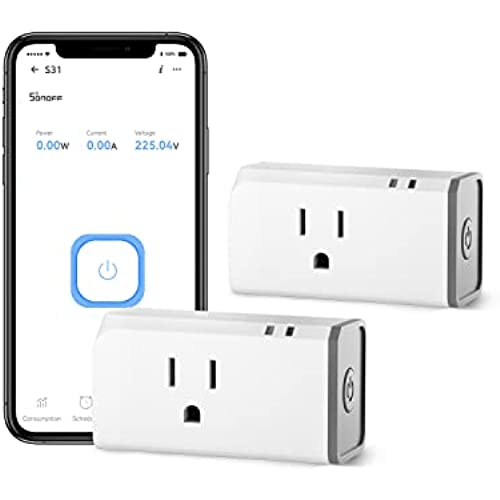
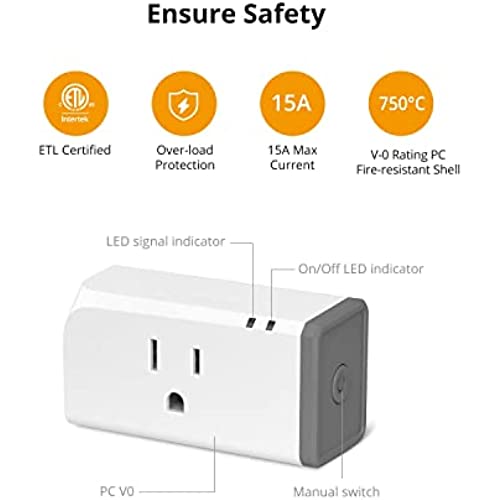
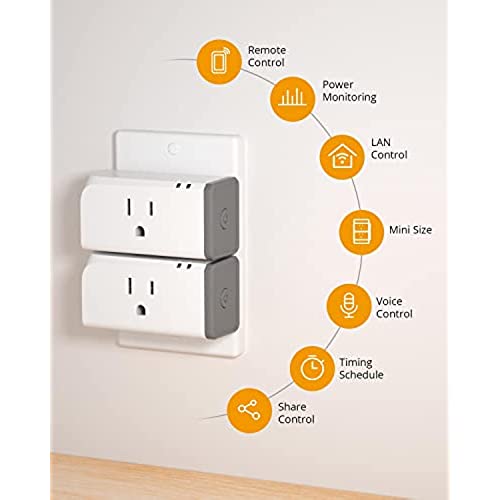
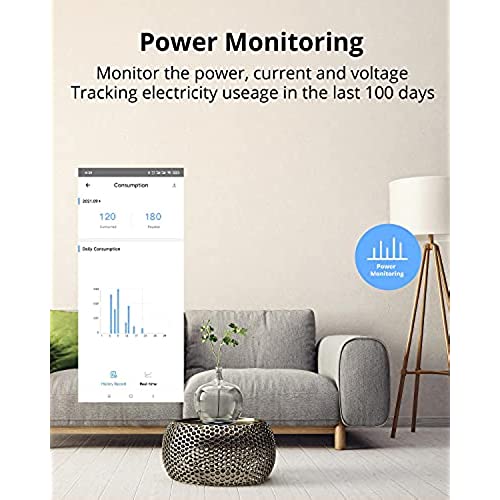
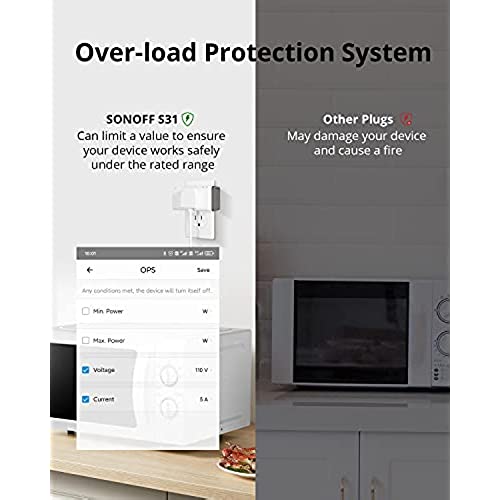









SONOFF S31 WiFi Smart Plug with Energy Monitoring, 15A Smart Outlet Socket ETL Certified, Work with Alexa & Google Home Assistant, IFTTT Supporting, 2.4 Ghz WiFi Only (2-Pack)
-

ComradeKarl
> 3 dayEasy to disassemble and flash with tasmota, exactly what I was looking for. Works with energy monitoring in home assistant through cloud on factory firmware, or locally on tasmota.
-

Careful Consumer
> 3 dayThese were not so easily added to the Alexa controlled system. Instructions did not track with the way I had to install them. The plug is large and the light/button, instead of being on the front, is on the side which means horizontal outlets, depending on orientation, may make it impossible to see the status light.
-

Miguel S.
> 3 dayExcelente compra, la configuración con la app eWelink se debe realizar primero via bluetooth y luego si enlazar al wifi 2.4Ghz. A través de ésta app se puede visualizar el consumo real de electricidad del aparato conectado. Enchufes muy estables, espero tengan la durabilidad adecuada
-

Princess Lucky
> 3 dayI really wanted a smartplug with good energy monitoring data. However, this device/app only gives you historical data in per day units and only in kilowatts. What about per second/min/hour? Or amps/milliamps/kiloamps? Or regular watts? As such, this only really is useful for recording your daily energy usage. As such, this is useless for someone like me, who is looking to observe changes in electrical consumption when I plug in/out any device in the house, or when I turn on/off a fan or anything else. The data also updates very slowly, taking a minute or two to read the energy consumption, and is incorrect. I have another energy monitoring smartplug that gives consistent rapid accurate data, and the SONOFF branded one is always off. This gets 1 star for being somewhat functional and an additional star for the price per value, but at 2/5 stars, I recommend you look at other options.
-

Stark
> 3 day2 out of 4, S31 WiFi Smart plugs failed to stay on after 3,weeks. Trying to contact seller for replacements.
-

Dustan Dennington
> 3 dayI have a dozen of these to monitor and control roof heaters remotely. Also use to automatically turn off space heaters.
-

SarahJo Griggs
> 3 dayThis has been our favorite smart plug for quite some time. And now being UL listed just edges it up a little higher. Two of the plugs fit fine in the same socket without forcing anything. If you want to manually flash them with Tasmota or some other open source firmware, the WiFi PCB on them is the same as it was previously so all the profiles/templates will work just fine. The product is still held together with screws and no glue so it goes back together super easy.
-

David
> 3 dayI bought a 4 pack of the S40 plugs and had 2 dead out-of-the-box. The other 2 paired up, and worked for just over 24 hours. I woke up to find these 2 flashing my lamps on and off. The app showed them both off-line. Button pressing on the plugs had no effect. When I unplugged them, the button lights would not light up when plugged back into the wall socket. I tried contacting the manufacturer, received a fairly quick response, and was advised to return them to Amazon. I did, and requested a replacement. I received the replacement, and had 1 die within 6 hours. The other 3 lasted almost 48 hours. This morning I found my lamps flashing on and off again. I am sending these back and can not recommend these.
-

J. Whiteside
> 3 dayLike many other reviewers, I have purchased this particular switch to install Tasmota on. I use them for energy monitoring, and in some cases their original intent - outlet switching, in my home. I buy whatever pack is cheapest per unit at the time, be it 1, 2 or 4 pack versions. Theyre all the same in my experience. To get them installed with Tasmota, I first tried to solder leads to them. Then I tried to solder pin headers and that was a little bit easier. Im slightly beyond entry level skill with soldering, but I destroyed at least three units in this learning process. I finally graduated to micro-grabber electrical test clips and have ripped through over two dozen conversions now without incident. Lets be frank. Id rather Sonoff just offered Tasmota OS from the get-go, or made these over-the-air flashable. I will settle for nothing less than local control and Im definitely not itching for a new and different cloud solution or app. Id prefer not to hack these devices in the first place and if Sonoff works towards preventing this from a hardware or software standpoint, I will buy no more of them. At the time of this writing (March 2022), this is probably one of the cheapest way to get local energy monitoring and basic 15 amp capable on/off outlet switching. I use Home Assistant for my home automation platform. These are fully compatible with their new energy monitoring dashboard. This provides me with significant insight into my homes energy use, especially now that theyre widely distributed to the overwhelming majority of my outlets. I usually capture between 13-18 kilowatt hours per day, the bulk of my usage. To be clear, I use higher grade energy monitoring switches in mission critical applications (furnace, fridge, etc.), but these are great even for non-mission critical high amp usage scenarios up to 15 amps. Ive pushed some of mine well up to the limits and havent had any major problems or sparks fly. Out of a couple dozen, Ive had one actual device failure. Oddly enough, even with different firmware, different units operate differently on my WiFi. Some stay connected to Wifi 100% of the time, others intermittently connect throughout the day. I dont lose any granular Home Assistant data because of this, nor are they ever inaccessible and fail to turn on/off. I dont have a good answer as to why different units behave differently with the same software. Odd behavior, but it doesnt result in problems. I really cant complain anyway, Im using them well outside of the manufacturers intended use. Build quality is good enough but I wish there was a bit more consistency. Since the majority of buyers are intending to hack these, I really wish they wouldnt cinch down some of the poor-quality screws like they are Shee-Ra or the Hulk. Ive destroyed way more screws than Ive wanted, and thats with the perfect screw removal tool which Ive determined to be a 2.0mm flathead screwdriver. Again, I just wish I could buy a decent quality, super cheap, 15 amp capable smart switch product with the OS of my choice out of the gate. Ive used these to solve VERY REAL problems in my home. From triggering outlets based on other inputs to making serious dents in energy conservation, I believe the $200ish dollars Ive put into these Sonoff S31 units will eventually pay for themselves. Its fairly easy for me when Im paying almost $0.25 per kilowatt hour, others might not have as good of an ROI. If anything, Ive achieved some level of energy usage consciousness. Ive killed and/or automated quite a few parasitic energy draws I wasnt even aware of, and have easily increased my automation abilities at the same time. Its important to know that these utilize about 2 watts each, just to function. This might not seem like much, but with two+ dozen of them running 24 hours a day - were talking about a ~50 watt constant load just to monitor outlet energy. For me, Ive killed and automated much more than that, so Im in the black as it were. Its important, at least for me, to keep tabs on the cost and value of energy monitoring. Im hoping I can continue to use these to save at least $500 in energy in the next 5 years, and so far, that seems to be a reasonable goal based on how I use them. Lastly, I dont want to get too much into minutia, but you need a fairly robust WiFi network to support the internet of things over WiFi. Personally, I utilize multiple networks, including Lutron, Z-Wave, Zigbee and WiFi to get there. Put simply, I dont use these cheap and ubiquitous hacked WiFi devices to service mission critical applications in any way. If a failure would cost me a fair bit of money, I spend more than $10 to capture energy usage and (sometimes) provide switching capabilities. +4 stars for being a hackable and very useful device overall. You can debate about that last star, even I waver between 4 and 5 stars. They provide much value for not much dollar and a reasonable +/-2 year path to return on investment for many people that are trying to optimize energy consumption or provide local, automated switching controls.
-

Luke Liem
Greater than one weekI bought a single S31 to figure which of my appliances was the most power-draining. What I did is simply use the single S31 power plug to monitor each suspect appliance for 2-3 days. The Android App has a kWh power consumption meter which you can start and stop. I was able to find out that my refrigerator was actually the culprit, using about 2kWh a day. I would have given the S31 a 5-star but for the fact that the software app is not the most intuitive to use. But it does the job and the S31 plug itself is only $15.
